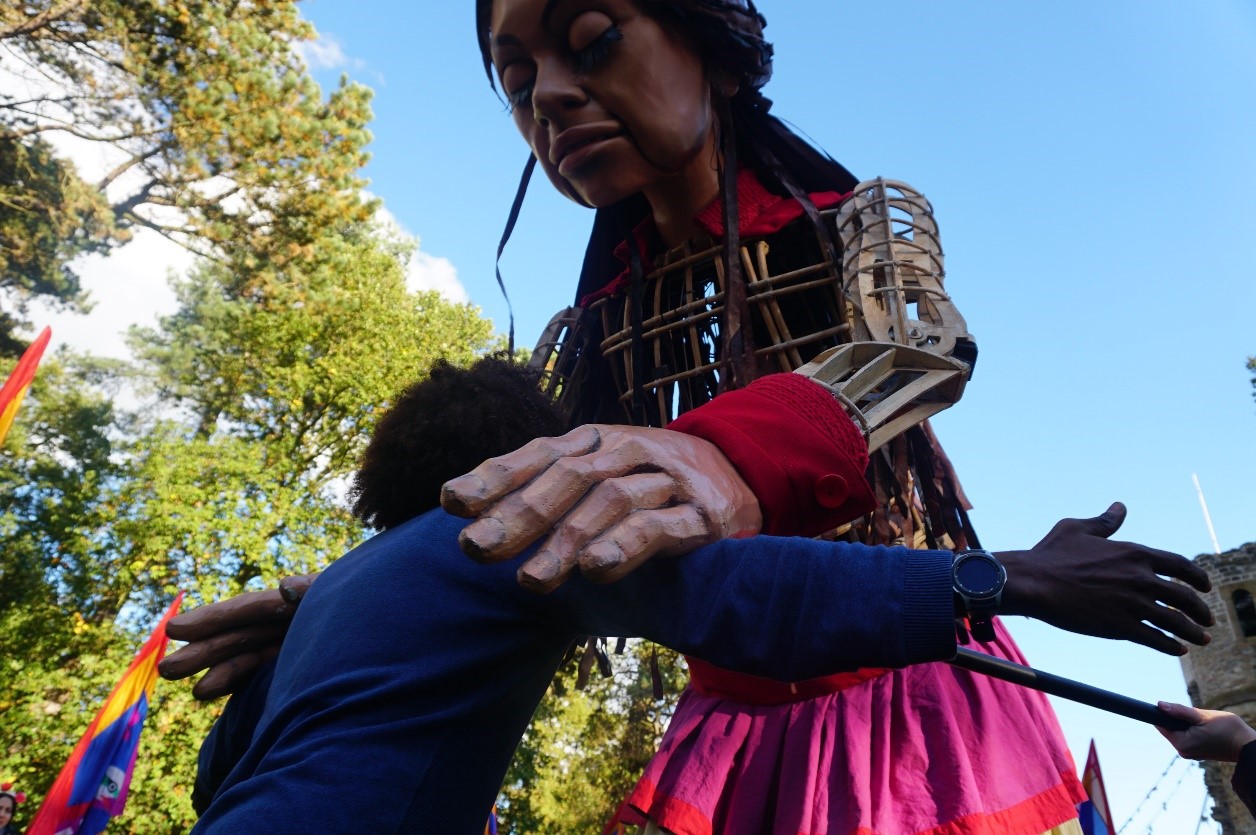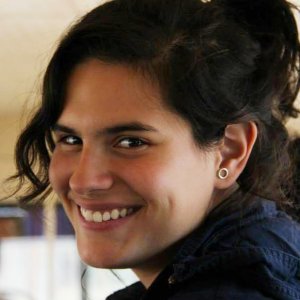If there’s something I have learned from my migratory process it is that it is important to have something to look forward to. That’s what kept me sane and that’s what Little Amal meant for me.
Before coming to the United Kingdom (UK) I read about a giant puppet called Little Amal who was going to walk from the Syrian border with Turkey to Manchester. I was fascinated. When I got to the UK I looked for the events calendar and saw that the puppet’s arrival was taking place around October. This made me think about my ongoing journey and the possibility of my visa application being rejected. Would I actually be able to see Little Amal? Nevertheless, I started to ask the people I met in the UK if they knew anything about it. Many of them didn't, so in order to keep informing people I chose to look into it further...
Little Amal is a 3.5 metre tall puppet created by the Good Chance Theatre company and the Handspring Puppet Company to present "The Walk", a travelling arts festival in collaboration with roughly 250 partners across over 70 cities, towns and villages in support of refugee children.
The story of Little Amal is the story of a 9 year-old girl travelling 8,000 km from the Syrian border to the UK. In the story she's portrayed as a refugee, but technically she would be an unaccompanied asylum seeker, and if we look more closely at her route, there are other technicalities that similarly we could point out. But what's more important to highlight is that her journey raises awareness of the – so called – refugee crisis and reflects the reality of thousands of unaccompanied refugee children who have been and still are forced to undertake extraordinary journeys like hers.
This is the story that I started to follow, and is the story that brought people together to welcome her, celebrating resilience, courage and hope. Communities around the world were showing what welcoming asylum seekers could and – in my opinion – should look like. But Little Amal also brought people that felt differently. It showed how some could feel threatened by a puppet refugee child – their reaction shedding light on the struggle and challenges that many young people, like Amal face throughout their journey and in their day-to-day lives.
A few weeks after "The Walk'' started in Turkey I found out that the Home Office accepted my visa, which meant a lot of different things for me. After processing the news I realised that I was going to be able to attend Little Amal events and I began looking into the events straight away. I thought that maybe I could attend the ones in London, Sheffield and potentially Manchester – each location for a different reason, which eventually would change due to my participation in the MIMY project.
Seeing the big picture: London
After months of following "The Walk", my experience in London was an immersion into the ‘big picture’ of Amal’s presence in the UK. For example, among the audience, I identified people who in the past months I've begun to recognise as part of the migration sector in the UK at "Welcome Wishes", the event which as part of the London Literature Festival welcomed Amal at the Southbank Centre. Furthermore, in the London events, as in many other events across the UK, I could really feel the presence of the hundreds of people that were gathered and moved by the amazing acts of welcome, as well as Amal’s reactions to these very acts and presence. This is what I saw outside the National Theatre, where we were all amazed by the incredible voice of Juliana Yazbeck and the choirs supporting her from the National Theatre's terraces. Similarly, I was amazed by the atmosphere that was created at Somerset House's courtyard while the talented dancers from the National Youth Dance Company and the Company of Elders welcomed her before she went to rest before her 10th birthday party at the Victoria & Albert Museum the next day, where lots of children got to meet her, play with her, as well as share the cake that the very well-known chef Yotam Ottolenghi made for her.
Fostering new relationships: Sheffield
A few days later I was lucky enough to go with some of my colleagues who are peer researchers in the South Yorkshire (UK) team of the MIMY project to the welcome that took place in Sheffield, a city that among other things is known for its creative arts scene, as well as for being the place where the City of Sanctuary movement in the UK began in 2005. Amal arrived at Victoria Quays by boat, a powerful image that surely sought to continue portraying the way in which many unaccompanied asylum-seeking children seek safety. The welcome was just as I imagined that a welcome event could be in Sheffield; warm, friendly and full of solidarity, among whom I could recognise some familiar faces, and greet and meet new people as well. After the event at Victoria Quays we walked to the Tudor Square, where she would arrive a few hours later. We could hear the One World Choir in the distance, as well as appreciate some ornaments where Welcome Amal could be read in English and Arabic.
Connecting to the personal: Barnsley
The next day I accepted one of my youth co-researcher’s invitation, to what for me was the most unexpected – as I was planning to attend the Manchester final event – and amazing event. This took place in Barnsley, but more specifically in Wentworth Castle, a historical building with a very interesting history and purposes, which throughout the years have fortunately changed, where I was lucky enough to meet Salvadoran, Tamil Malaysian, Polish, Kurdish and Iranian people, who, like me, are looking to build a life in the UK. They are part of a group called Feels Like Home in Barnsley, a group that my colleague spoke to me about and mentioned being part of almost from its beginning. I learned a lot from him that day as he shared some of his broad knowledge with me about the area and his experience as an interpreter, and similarly, I had the opportunity to see him as part of a group and a community in which he is involved, appreciated, as well as respected.
He told me that during the week, Feels Like Home organised the preparations for "The Way Home" event; they made headbands and sashes that were worn by some of the people who held incredible flags designed by them and made by a South Yorkshire local artist who guided them in the creation of some giant flowers that were to be delivered for Amal during the event. As my mother tongue is Spanish I was talking with a Salvadoran family and an Argentinian woman, and we were approached by whom I now know was Dina Mousawi, Creative Producer of Good Chance Theatre, who asked us to hold some of the giant flowers that then she explained would become a bunch of flowers for Amal. She explained what we had to do and when, but when I accepted I never imagined that the experience was going to be as beautiful as it was.
I have a panoramic memory of that moment, and I will keep it just as Amal keeps collecting hers: closing my eyes, opening them to look up to see my flower, and realising what a beautiful day it was as I saw the sky, where I could see the sun shining and its light showering the autumn trees while a young girl was reciting a poem and then looking at the amazing people I met there waving their flowers while in the background my co-researcher was smiling while taking a photograph as Amal leaned towards where he and other people were.
I think following this wonderful project closely, and considering the part that would take place in the UK as something to look forward to was a great decision because being able to walk with Amal in different stages of her journey, as well as seeing and being part of the amazing acts of welcome has given me so much joy. In a way I am deeply grateful to the Good Chance Theatre and their partners all across the world for creating a space where we could all gather around a shared belief.


Images: Title image (c) Amanuel Tesfay; Second image (c) Abdallah Farrag.


